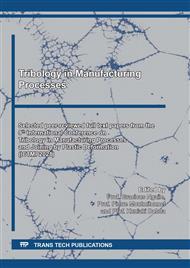p.125
p.133
p.139
p.147
p.155
p.163
p.169
p.179
p.185
Temperature Dependency of Friction of Titanium Alloy by Forward Rod-Backward can Combined Extrusion Test
Abstract:
Forward rod-backward can combined extrusion test was used to investigate the tribological properties of Ti-6Al-4V titanium alloy with oxide film at cold and warm forging conditions. 0.08 and 0.10 µm-thick oxide films were formed on the test piece by atmospheric oxidation treatment. A friction test was performed without using lubricants. As a result, the oxide film was effective to prevent seizure at cold forging condition, where the friction coefficient was estimated as about 0.15. However, at warm forging condition, a decohesion of the oxide film and seizure occurred, where the estimated friction coefficient was larger than that at cold forging condition. Furthermore, thickening the oxide film was effective against the decohesion and to reduce the friction coefficient.
Info:
Periodical:
Pages:
163-168
Citation:
Online since:
February 2022
Authors:
Keywords:
Price:
Сopyright:
© 2022 Trans Tech Publications Ltd. All Rights Reserved
Share:
Citation:


